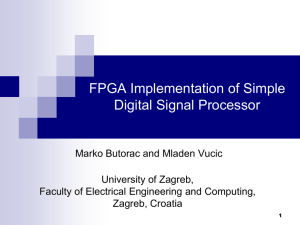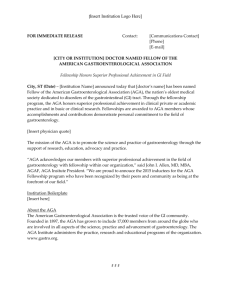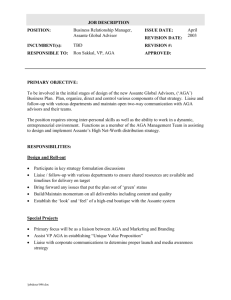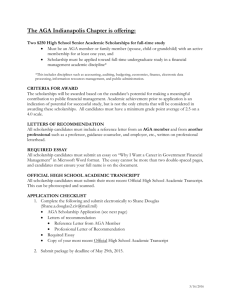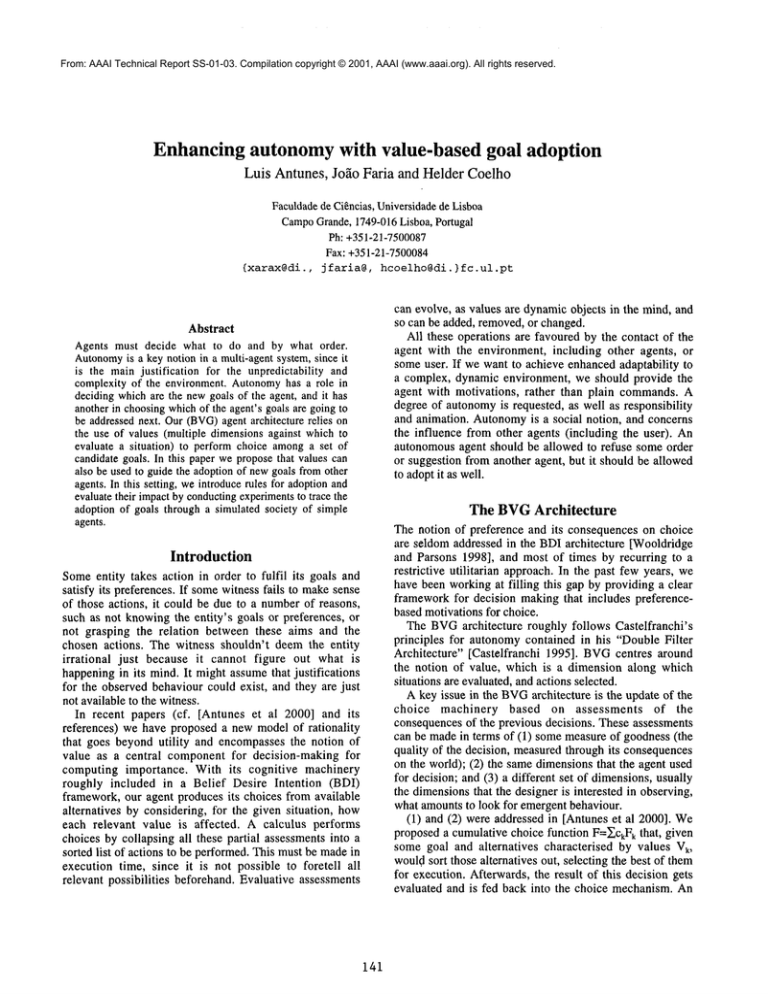
From: AAAI Technical Report SS-01-03. Compilation copyright © 2001, AAAI (www.aaai.org). All rights reserved.
Enhancing autonomy with value-based goal adoption
Luis Antunes,Jo~o Faria and Heldcr Coclho
FaculdadedeCi~ncias, UniversidadedeLisboa
CampoG~nde,1749-016Lisboa, Po~ugal
Ph:+351-21-7500087
Fax:+351-21-7500084
{xarax@di.,jfaria@,hcoelho@di.}fc.ul.pt
can evolve, as values are dynamicobjects in the mind, and
so can be added, removed, or changed.
All these operations are favoured by the contact of the
agent with the environment, including other agents, or
someuser. If we want to achieve enhancedadaptability to
a complex, dynamic environment, we should provide the
agent with motivations, rather than plain commands.A
degree of autonomyis requested, as well as responsibility
and animation. Autonomyis a social notion, and concerns
the influence from other agents (including the user).
autonomousagent should be allowed to refuse someorder
or suggestion from another agent, but it should be allowed
to adoptit as well.
Abstract
Agents must decide what to do and by what order.
Autonomy
is a key notion in a multi-agentsystem,since it
is the mainjustification for the unpredictability and
complexityof the environment. Autonomy
has a role in
deciding whichare the newgoals of the agent, and it has
anotherin choosingwhichof the agent’sgoals are goingto
be addressednext. Our(BVG)agent architecture relies
the use of values (multiple dimensionsagainst whichto
evaluate a situation) to performchoice amonga set of
candidategoals. In this paper weproposethat values can
also be used to guide the adoptionof newgoals fromother
agents. In this setting, weintroducerules for adoptionand
evaluatetheir impactby conductingexperimentsto trace the
adoption of goals througha simulated society of simple
agents.
The BVGArchitecture
Introduction
Someentity takes action in order to fulfil its goals and
satisfy its preferences. If somewitness fails to makesense
of those actions, it could be due to a numberof reasons,
such as not knowingthe entity’s goals or preferences, or
not grasping the relation between these aims and the
chosen actions. The witness shouldn’t deem the entity
irrational just because it cannot figure out what is
happeningin its mind. It might assumethat justifications
for the observed behaviour could exist, and they are just
not available to the witness.
In recent papers (cf. [Antunes et al 2000] and its
references) we have proposed a new model of rationality
that goes beyond utility and encompasses the notion of
value as a central component for decision-making for
computing importance. With its cognitive machinery
roughly included in a Belief Desire Intention (BDI)
framework, our agent produces its choices from available
alternatives by considering, for the given situation, how
each relevant value is affected. A calculus performs
choices by collapsing all these partial assessments into a
sorted list of actions to be performed.This must be madein
execution time, since it is not possible to foretell all
relevant possibilities beforehand. Evaluative assessments
141
The notion of preference and its consequences on choice
are seldom addressed in the BDIarchitecture [Wooldridge
and Parsons 1998], and most of times by recurring to a
restrictive utilitarian approach. In the past few years, we
have been workingat filling this gap by providing a clear
frameworkfor decision making that includes preferencebased motivations for choice.
The BVGarchitecture roughly follows Castelfranchi’s
principles for autonomycontained in his "Double Filter
Architecture" [Castelfranchi 1995]. BVGcentres around
the notion of value, which is a dimension along which
situations are evaluated, and actions selected.
A key issue in the BVG
architecture is the update of the
choice machinery based on assessments
of the
consequencesof the previous decisions. These assessments
can be madein terms of (1) somemeasure of goodness (the
quality of the decision, measuredthrough its consequences
on the world); (2) the same dimensionsthat the agent used
for decision; and (3) a different set of dimensions,usually
the dimensionsthat the designer is interested in observing,
what amountsto look for emergentbehaviour.
(1) and (2) were addressed in [Antunes et al 2000].
proposed a cumulative choice function F=]~CkFkthat, given
some goal and alternatives characterised by values Vk,
wouldsort those alternatives out, selecting the best of them
for execution. Afterwards, the result of this decision gets
evaluated and is fed back into the choice mechanism.An
appropriate function performs updates on the features that
are deemedrelevant for the decision. For case (1), function
G takes an assessment in dimension Vn, and distributes
credit to every Vki, feature of winningalternative i. In case
(2), a more complexfunction H takes a multidimensional
assessment in V~x...XVn.
Case (3) relates the evaluation of the experimentsto the
behaviours of the agents. Wehave a keen concern for
autonomousbehaviours. But autonomycan only be located
in the eyes of the observer. To be autonomous, some
behaviour need not be expected, but also not extravagant.
This hard-to-define seasoning will be transported into our
agents by an update function such as described above, but
one that doesn’t depend exclusively on agent-available
values.
Autonomy in BVG
Wepropose several steps in this movetowards enhanced
autonomy.First, let us observe that adaptation and learning
should be consequences of the interaction between the
agent and the world and its components.If the agent would
adapt as a result of any formof orders from its designer, it
wouldn’t be adaptation or learning, but design. Of course,
if the agent is to respond to a user, this user should be
presentin its world.
Agents can share information, in particular evaluative
information. Mechanismsto deal with this information can
be fit into BVGin two different ways. (1) An agent
receives information fromanother and treats it as if it was
an assessment madeby himself (possibly filtered through
credibility assignment function). Choice can be performed
as always, since the new information was incorporated into
the old one and a coherent picture is available. (2) The
receiving agent registers the newinformation together with
the old one, and all is considered together by the choice
function F when the time comes. A new component of F,
say F,,+j, deals with the ’imported’informationseparately.
Agents can also share goals. They can pick goals from
each other for several reasons. Wetry to characterise those
reasons by recurring to values. Wehave addressed the
adoption of goals by imitation (see [Antunes et al 2000]).
Other reasons could be curiosity: the appeal of something
new in the absence of foreseen drawbacks; affect: the
adoption of somegoal just because it pleases (or serves)
anotheragent; etc.
Finally, agents can share values. In humans, the
acquisition of these takes years, and relies heavily on some
ingredients: some’higher’ value, or notion of what’s good
and what’s bad, that, by the way, we wouldpostulate as a
commonelement to any ontology of values; intricate
dedicated mechanisms, that include some of the ones we
have been addressing, but also more difficult ones like
kid’s playing and repeating (as opposedto usual computerlike ’one-shot comprehension’ [Monk 1998]). Our
mechanismsfor value sharing are necessarily simple, and
consist basically of conveying values and respective
componentsof the choice and update functions.
142
Information Exchange
We want our agents to communicate with each other
within some agency. Westart by describing the way they
exchangeinformation. To simplify, agents only tell other
agents about their opinion on some feature of the
alternative. The agent that receives the information can
either (i) incorporate it into its ownknowledge,or (ii)
register this information and consider it whenmakingthe
next choice.
Option (i) leads to an operation similar to an update
cause by the agent’s ownevaluation. If the credibility is 1,
the receptor agent considers the informationas goodas if it
were its own conclusion.
We give an example for
dimensionquality. Supposethat agent a (whosecredibility
for b is c>0.5) tells agent b that quality of w is q, after
evaluations. If b knowsnothing about the quality of w, b
will accept this information unconditionally. If b believes
quality(w,q’, n’), then it will changethis impressioninto
(n’xq’)+(n×q×c)
quality(w,
n’+nxc , n’+nxc).
In option (ii), agent b will only register the information
that was conveyedto it. Whenlater it will have to makea
decision, this information will be taken into account as
follows. The agent will consider (say) quality(w, ~, ~),
meanvalues of what it was told concerning the quality of
w, weighted by the credibility of the emitter agents. When
nothing was told about some dimension of w, a default
value is considered. Then b’s choice function is changedto
incorporate a further component, FT, which uses F to
compute the ’global value of all suggestions.’ The new
choice function, F’, is again ~ckFk, with k nowranging
from 1 to n+l. The suggestions b receives are hence
filtered by b’s own choice machinery, and they are
cumulativelyincorporated in F’ with the desired weight.
Goal Adoption
Castelfranchi [1995] defends an agent should adopt a goal
only if this newgoal serves an already existent goal of his.
Wehave embodiedthis idea into a goal adoption rule and
expanded it into value-based goal adoption. The general
mechanismwe introduced was that of imitation. A possible
goal is perceived and considered for adoption according to
the agent’s values. In the case we wanted to maintain
Castelfranchi’s rule, our rule was to adopt the candidate
goal if there would be already a goal that shared some
value with the newgoal to be adopted. In the absence of a
goal to be served by the goal candidate for adoption, we
proposed another rule that would base adoption upon the
values concerningthe imitated agent:
adopt(agA,goal(agB, G0,Vl=o~l..... Vk=ok)
) if
3bel(agA,val(agB, Vi=~i,, .... Vi=~j)!:
3val(agA,Vi=~i..... "~i=~j):
~’m: i<m<j, sameValue(~m,~m’)
A slightly different rule of adoption by imitation, comes
from adapting Castelfranchi’s requirement, by weakening
the final condition linking the twogoals, i.e., the values of
agB are knownthrough the description of its goal Go, and
it suffices for agA to have one value coincident with the
ones of agB (we could have used agA’s goals to infer its
values, but conflicts mightoccur):
adopt(agA,goal(agB,Go,Vl=tol ..... Vk=%))
3val(agA,Va=~a):3ie {1 ..... k}:
sameValue(o~i,~a)
A new mechanism for value-based adoption would be
curiosity. Anagent will adopt a goal from another agent if
all of the values involved in this goal are completely new
to him:
adopt(agA,goal(agB, Go,Vt=o)
l ..... Vk=C0k)
) if
-~a: { l<a<k ^ val(agA, V~=~a)}
Sharing Values
An agent will share its values by makingavailable their
associated parameters and mechanisms. The decision of
whether to adopt or not could be taken by considering
higher values. At our present stage, instead of postulating
one or morehigher values, we consider the value affinities
between exchanging agents. Wepropose several rules,
such as the existence of (a) one, (b) the majority or (c)
values in common.
Whenan agent (agA) decides to accept another agent’s
(agB) particular value (Vk), agB’s standards for Vk
accepted by agA, both in terms of scale (Sk), and agB’s
default position towards that scale. At this stage, agAwill
also accept agB’s choice function componentFk, i.e., agB’s
relation to Vk, a mappingfrom Sk to the interval [0,1],
where F takes values. Weshow only rule (c). In what
follows, Vkis a value, andSk, ~k ~ Sk.
Accept(agA,val(agB, Vk=~k))
’v’val(agA, Vi=~i), 3bel(agA,val(agB, Vj=Vj)):
sameValue(~i,~j)
Whenthis condition is met, agA will take on all agB’s
definitions related with Vk: its scale Sk and respective
default mean value Sk; agB’s position towards Vk, ~k;
Fk(agA,.) becomes equal to Fk(agB,.); and F(agA,.)
modified to incorporate Fk with coefficient Ck inherited
from agBand adapted to cope with the other agA’sc~s.
Finally, all agB’s update functions mentioning Vk and
relevant to agA’snewset of values are transferred to agA.
It could be interesting to transfer all update functions
mentioning Vk tout court, to let agA have contact with
new, not completely mastered values (unlike this process
of transference, whichis rather complete).
Results
A series of simulations addressed the issue of goal
exchange. The most interesting result comesfrom crossing
these simulations with the choice-perform-update ones. We
concluded that what were the reasons for the selected
actions mayhave been lost, with a high probability. Agents
are committedto selections but they no longer have access
to the rationality that caused those commitments,and so
will have trouble deciding whether or not to keep them.
143
Even worse, this hazards the update process and
undermines the whole choice model, since this model by
and large dependson a feedbackcircle that is nowbroken.
It is apparent that the overlooking of grounded goal
managementwas the cause for this problem. The focus on
preference-based choice was too heavy, and a return to a
more solidly built mental basis may be in need, before
readdressing the choice issues. BDImodels could provide
this basis.
Conclusions
The main force behind the BVGarchitecture has always
been motivation: what makes us do what we do; what
allows us to balance what we ought to do, with what we
can do, with what we want to do. And even how do we
rationalise a bad (for our ownjudgement)decision in order
not to pain over it again and again. The BVGmodel
provides a framework where multiple values are used to
compute practical decisions (reasoning from beliefs to
values, to goals and actions), and then these values are
updated according to the outcomeof those decisions.
Our model departs from BDIby stating that agents need
reasons for behaviour that surpass the simple technical
details of what can be done, howit can be done and when
it can be done. These reasons (which we have called
’dirty,’ as opposedto ’clean,’ logical ones) are then the
basis of the agent’s character, and are foundedon values as
representatives of the agent’s preferences. The dropping of
those ’clean’ reasons was perhaps hasty, and even a
preference-conscious agent must possess a sound basis of
logical mental concepts on whichto ground. It is then only
natural to return again to BDI as a provider of such a
machinery, and to build the multiple-value modelon top of
it. Also, the necessity of goals on whichto base behaviour.
Values are not enough, even whenthey can cause goals to
be adopted.A careful weavingis still in order.
Acknowledgements
This research has been carried out within the research unit
LabMAC,and partially
supported by project Praxis
2/2.1/TIT/1662/95 (SARA).Wewould like to thank one
the anonymous
referees.
References
Antunes,L., Faria, J. and Coelho,H. 2000. Improvingchoice
mechanisms
within the BVG
architecture, in I’
Proceedingsof 7
ATAL(Agent Theories, Architectures and Languages), July,
BostonMA(to appearin Springer-Verlag).
Castelfranchi, C. 1995. Guaranteesfor autonomy
in cognitive
agent architecture, in Intelligent Agents, Agent Theories,
Architectures, and Languages, ECAI’94Workshop(ATAL),
Springer-Veflag,
LectureNotesin AI no. 890.
Monk,A. 1998. Cyclic interaction: a unitary approach to
intention, action andthe environment,
Cognition68.
Wooldridge, M. and Parsons, S. 1998. Intention
ReconsiderationReconsidered,in Intelligent Agents V: agent
theories, architectures, and languages,Proceedingsof ICMAS’98
workshop(ATAL),Springer-VeflagLNAI1635.

